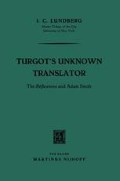Abstract
A coincidence so striking as to raise doubt of its being coincidence is the high representation in Smith’s library of persons whose names were on Turgot’s list to receive their copies of the 1770 tirage à part, the “restored” edition he asked to have, and paid to have, made of Réflexions.
Access this chapter
Tax calculation will be finalised at checkout
Purchases are for personal use only
Preview
Unable to display preview. Download preview PDF.
References
G. Schelle, Oeuvres de Turgot, III, pp. 383, 386. DuPont was instructed to have a copy bound in gold-tooled calfskin for the publisher (DuPont), one for Mme. Blondel, and a third for Mme. la duchesse d’Enville. In the “packages” to these ladies were to go copies in other bindings to names mentioned: i.e., with Mme. Blondel’s he is to send copies to M. de Malesherbes and to the Abbé de Véri. Gaillard is also on the first list, and on the second are also M. de Saint-Péravy and Mme. de Pailli, besides those we have named.
T. Yanaihara, A full and detailed Catalogue of Books which belonged to Adam Smith, p. 98. Appendix II, p. 73 ff., reproduces a very remarkable document, “A Catalogue of books belonging to Adam Smith, Esqr., 1781.” It is a handwritten manuscript, the calligraphy that of Smith or of a contemporary, consisting of 87 sheets, together with 3 blank sheets, and was originally drawn up by or for Adam Smith. In organization it is unique, in that it proceeds, division by division, bookcase by bookcase, shelf by shelf in each bookcase, and includes whatever was “Lying on the top” of each. In the Kress Library of Business and Economics, within the Baker Library, at Harvard’s Graduate School of Business Administration, there is a record of this document made on 12 typewritten sheets by Prof. W. R. Scott.
Ibid., p. 93.
Ibid., p. 97. The insertion “(sic)” made in Japan.
Ibid., p. 98.
Ibid., p. 80.
Ibid., p. 102-103.
Ibid., p. 97. Cf. W. R. Scott, Adam Smith as Student and Professor, p. 345n. “There was a copy of the Essai in Adam Smith’s Library… As early as 20th May, 1751, there was a column advertisement in the Glasgow Courant… The University bought the second edition, and between 1755 and 1758 Adam Smith was instrumental in procuring for the Library Savary’s Parfait Négociant… which had been largely used by Postlethwayt.”
Schelle, op. cit., p. 385. Turgot has told DuPont he will pay for the 100 or 150 copies of the corrected reprint edition. In an earlier letter (op. cit., p. 58) he tells DuPont he has forgotten to ask him for 200 copies of the Rémonstrances des Etats de Languedoc, and he will do him the favor of sending him the bill for the same. References are frequent to the ways in which Turgot plans to have DuPont paid for things he has printed.
Yanaihara, op. cit., p. 98-99.
Ibid., p. 75, Oeuvres de Jean Jacques Rousseau Toms 10 & 11 p. 76, Pieces Relatue a J. J. Rousseau Rousseau Citoyen de Geneve A Mr. D’alembert P.99, Oeuvres Diverses de M. Rousseau de Geneve. 2 Toms p. 116, Julie ou La Nouvelle Heloise, par Rousseau. 2 Toms Emile ou L’Education par Rousseau 4 Tom.
Anon., Private Correspondence of David Hume with several distinguished Persons between the years 1761 and 1776, p. 172 ff. Hume’s principal correspondent, the comtesse de Bouffiers, is much put out with him for having made the baron d’Holbach the first confidant of his quarrel with Rousseau. Hume’s letter to the baron, she tells him, “had been publicly read at a brilliant supper given by M. Necker”: it began with the words: “Mon cher Baron, Jean Jacques est un Scélérat.” Intemperate words, but occasioned by J.-J.’s letter to Hume beginning: “Vous êtes un traitre; vous ne m’avez pas mené ici [Scotland] que pour me perdre, après m’avoir déshonoré.”
Schelle, op. cit., II, p. 495-498. Here, 23 July, 1766, Turgot concludes, “Je ne connais point du tout Rousseau, que je n’ai vu que des instants dans le temps qu’il allait chez le baron d’Holbach”; and p. 659-662, letter of 25 March, 1767, in which Turgot assures Hume that his one motive in writing to advise him is his personal acquaintance with him, Hume, since he had never had any personal acquaintance with Rousseau.
G. Henry, ed., Correspondance inédite de Condorcet et de Turgot 1770–1779 p. 18. A letter of Condorcet to Turgot in the late summer of 1770 discloses a second pseudonym for this gentleman and supports Brunet’s view that the authorities shut their eyes when it suited them to do so. For the marquis is telling Turgot of Segnier’s ordering “a pleasantry forgotten for fifteen years” to be burned and its author proscribed. The author, M.Bernier, says Condorcet, “is a name in thin air, and they know it.”
Yanaihara, op. cit., p. 73.
A. Neymarck, Turgot et ses Doctrines, II, p. 307. His nomination, March 1776, was announced by a predecessor as Contrôleur-Général, L’Averdy.
Ibid., p. 306. Turgot was nominated to the place in the Académie Française left vacant by the death of the duc de Saint-Aignan. Condorcet was chosen to deliver the invitation to Turgot. He, seeing his downfall almost certain, declined, proposing two other names.
Ibid., p. 345-346.
In 1777 Turgot was Vice-Director of the Académie (“J. M. B.,” Anne-Robert Jacques Turgot, p. 26).
Schelle, op. cit., III, p. 560; and earlier, p. 250-255.
Ibid., IV, pp. 500, 503.
Ibid., p. 515-520.
Yanaihara, op. cit., p. 103.
Ibid., P.101.
The Economic Journal, No. 21 (March 1896), 6: 166.
D. Stewart, The Works of Adam Smith, V, p. 467.
Author information
Authors and Affiliations
Rights and permissions
Copyright information
© 1964 Martinus Nijhoff, The Hague, Netherlands
About this chapter
Cite this chapter
Lundberg, I.C. (1964). Library. In: Turgot’s Unknown Translator. Springer, Dordrecht. https://doi.org/10.1007/978-94-011-9592-8_8
Download citation
DOI: https://doi.org/10.1007/978-94-011-9592-8_8
Publisher Name: Springer, Dordrecht
Print ISBN: 978-94-011-8738-1
Online ISBN: 978-94-011-9592-8
eBook Packages: Springer Book Archive

